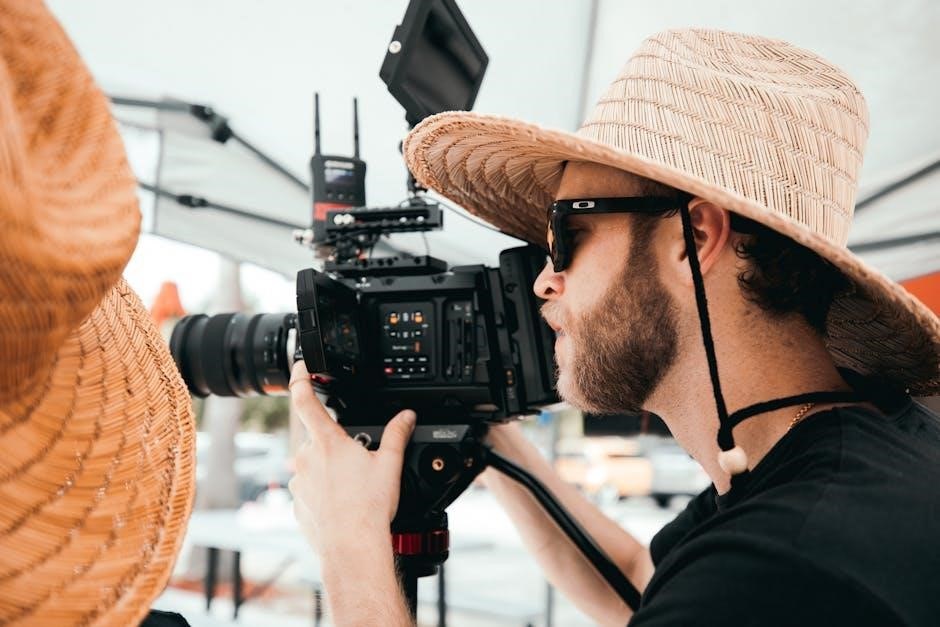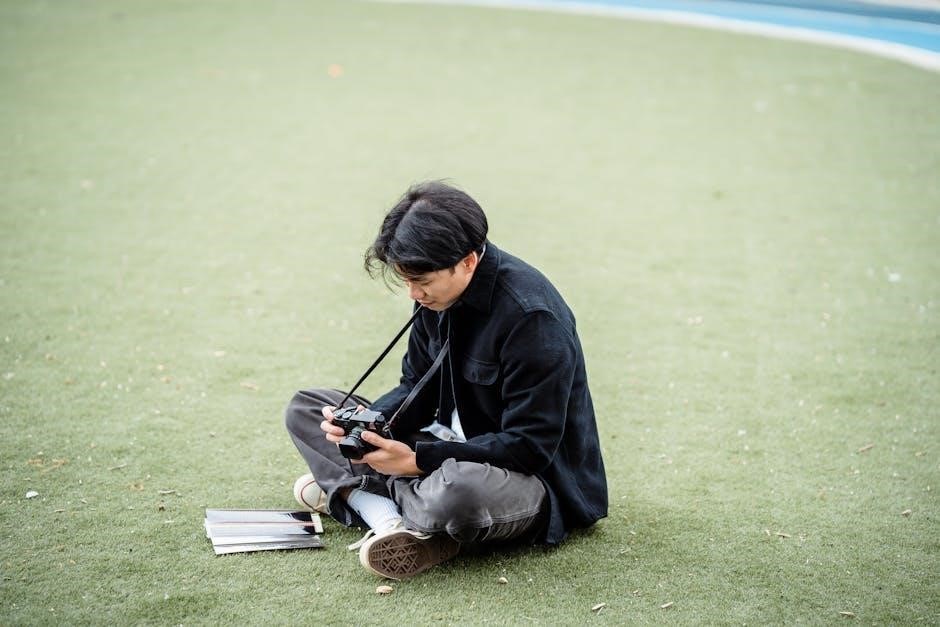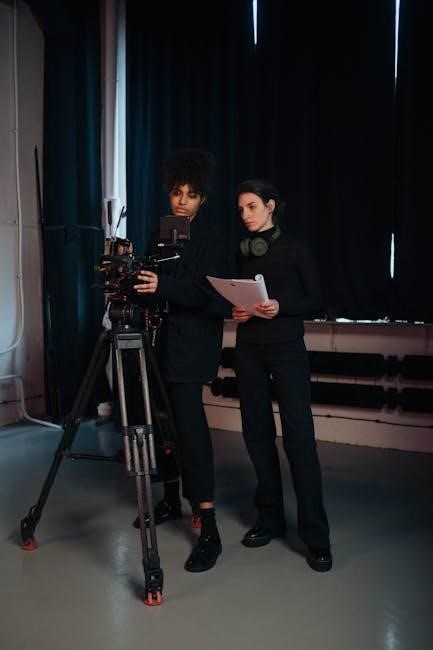offers a comprehensive guide to film analysis‚ featuring enhanced video resources and interactive media. Available as an eBook or PDF‚ it provides in-depth insights for film students and educators‚ making it an essential tool for cinematic study.
Overview of the 7th Edition
presents a refined and enhanced approach to film studies‚ offering a robust framework for understanding cinema. It includes updated video resources‚ interactive media‚ and assessment tools‚ making it a versatile resource for both students and educators. The edition emphasizes a deeper exploration of film language‚ narrative structure‚ and artistic elements‚ while also addressing cultural and historical contexts. New and refreshed content ensures relevance and engagement‚ providing learners with a comprehensive foundation for critical analysis. Available in both PDF and eBook formats‚ this edition is accessible and user-friendly‚ catering to the evolving needs of film students and scholars alike.
Key Features of the Updated Edition
boasts several key features that enhance learning and engagement. It includes new and refreshed video resources‚ interactive media‚ and assessment tools‚ making it a dynamic and assignable resource for film students. The edition also offers a robust framework for film analysis‚ helping learners decode the language of cinema with precision. Additionally‚ the updated version provides in-depth insights into narrative structure‚ artistic expression‚ and cultural impact‚ ensuring a comprehensive understanding of film studies. Available as a PDF or eBook‚ this edition is accessible and convenient‚ catering to modern learning preferences while maintaining academic rigor.
Importance of Studying Film as an Art Form
emphasizes the importance of film analysis‚ providing tools to decode the intricate language of cinema. By examining films‚ students gain insights into diverse perspectives‚ historical contexts‚ and artistic innovations‚ making film studies a vital part of a well-rounded education.

Film Analysis and Criticism
provides a robust framework for film analysis‚ supported by new video and interactive resources for deeper understanding.
Understanding Narrative Structure in Films
emphasizes the importance of narrative structure in storytelling. It guides readers to analyze how plots are constructed‚ characters develop‚ and themes emerge. The textbook provides tools to deconstruct scenes‚ identify key moments‚ and understand pacing. By exploring classic and contemporary films‚ students learn to recognize patterns and deviations in storytelling. The edition includes video resources and interactive media to enhance comprehension of narrative techniques. This focus helps film enthusiasts and students appreciate how stories engage audiences and convey meaning. The book’s structured approach makes it easier to grasp complex narratives‚ fostering a deeper appreciation for cinema as an art form.
The Role of Visual Design in Cinema
highlights the pivotal role of visual design in shaping cinematic experiences. Visual elements such as cinematography‚ lighting‚ and production design create the film’s aesthetic and atmosphere. The textbook explores how these components guide audience perception‚ evoke emotions‚ and reinforce themes. Through detailed analysis and video resources‚ students learn to decode visual motifs and their impact on storytelling. The edition emphasizes how visual design collaborates with narrative to immerse viewers in the film’s world. By examining iconic scenes‚ the book illustrates the transformative power of visual artistry in cinema‚ enabling readers to appreciate films as both stories and visual masterpieces.
Sound and Music: Enhancing the Film Experience
delves into the significance of sound and music in cinema‚ emphasizing their role in shaping emotional and narrative depth. The textbook explores how sound design‚ dialogue‚ and score collaborate to create immersive experiences. It examines techniques like diegetic and non-diegetic sound‚ illustrating their impact on storytelling. The edition highlights how music enhances mood‚ pacing‚ and character development‚ while sound effects add realism and tension. Through interactive media and video resources‚ students gain insights into sound’s contribution to the overall cinematic language. By analyzing iconic soundtracks and audio designs‚ the book underscores the transformative power of sound and music in filmmaking‚ offering a deeper understanding of their role in enhancing the viewer’s connection to the story.
Editing: The Backbone of Film Storytelling
emphasizes how editing transforms raw footage into a cohesive story. It explores techniques such as continuity editing‚ cross-cutting‚ and match cuts‚ which create seamless transitions and guide the audience’s focus. The textbook also discusses the role of editors in balancing action‚ dialogue‚ and music to maintain tone and rhythm. By analyzing iconic scenes‚ the edition demonstrates how editing decisions influence the viewer’s interpretation. Interactive media and video resources provide students with practical insights into the editing process‚ helping them appreciate its significance in crafting compelling cinematic experiences. This section underscores editing as the backbone of storytelling‚ essential for engaging audiences and conveying the director’s vision effectively.

The Artistic Elements of Cinema
The 7th Edition explores cinematography‚ lighting‚ and color as essential tools in visual storytelling. These elements create mood‚ depth‚ and emotional resonance‚ enhancing the cinematic experience.
Exploring Cinematography and Lighting
Cinematography and lighting are fundamental artistic elements in filmmaking‚ shaping the visual tone and emotional impact of a scene. The 7th Edition delves into how cinematographers use camera angles‚ composition‚ and lighting styles to convey mood and guide audience focus. Lighting techniques‚ such as high-key‚ low-key‚ and naturalistic approaches‚ are analyzed to demonstrate their role in creating atmosphere and depth. The book also explores the collaboration between cinematographers and directors‚ highlighting how their choices influence storytelling. Practical examples and case studies illustrate the transformative power of cinematography and lighting in iconic films‚ offering students a deeper understanding of their significance in cinematic artistry.
Color and Contrast: Visual Storytelling Tools
Color and contrast are powerful visual storytelling tools that shape the emotional and aesthetic impact of films. The 7th Edition explores how filmmakers strategically use color palettes to evoke emotions‚ establish themes‚ and guide viewer attention. Contrast‚ both in color and lighting‚ enhances visual depth and creates dynamic compositions. The book examines techniques like color symbolism‚ monochromatic schemes‚ and high-contrast ratios‚ illustrating their effects on mood and narrative. Case studies reveal how iconic films leverage color and contrast to convey meaning and engage audiences. These elements are essential for creating a visually compelling and emotionally resonant cinematic experience‚ as highlighted in the updated edition.
Acting and Character Development in Films
Acting and character development are essential elements in filmmaking‚ as they bring stories to life and engage audiences emotionally. The 7th Edition explores how actors use techniques like realism‚ formalism‚ and method acting to portray believable characters. It highlights the importance of dialogue delivery‚ body language‚ and facial expressions in conveying emotions. Character development is analyzed through arcs‚ showing how personalities evolve throughout a film. The book also discusses the collaboration between actors and directors to create compelling performances. By examining iconic roles and their impact‚ the edition emphasizes how strong acting and character development are vital for a film’s success and audience connection‚ making cinema a powerful storytelling medium.

Cultural and Historical Contexts
Film reflects and shapes cultural identity‚ societal values‚ and historical perspectives. The 7th Edition explores how cinema documents and interprets cultural shifts‚ historical events‚ and global movements‚ enriching our understanding of diverse human experiences through the lens of film.
Film as a Reflection of Society
Film serves as a powerful mirror of society‚ capturing the cultural‚ social‚ and political landscapes of its time. The 7th Edition highlights how cinema reflects societal changes‚ from civil rights movements to gender equality‚ offering insights into collective values and challenges. Movies like Guess Who’s Coming to Dinner and Parasite illustrate how storytelling addresses inequality and social justice. By examining films through a sociocultural lens‚ students understand how cinema not only entertains but also sparks dialogue about real-world issues. This section emphasizes the role of film in preserving history and inspiring change‚ making it a vital tool for understanding humanity’s shared experiences and evolving norms.
Historical Development of Film Technology
The evolution of film technology has been a remarkable journey‚ shaping cinema’s artistic and technical capabilities. From the invention of the kinetoscope in the late 1800s to the advent of digital cinema‚ technological advancements have continually transformed filmmaking. The Lumière brothers’ Cinématographe and Edison’s kinetograph laid the groundwork for motion pictures. The 1920s introduced sound with “talkies‚” revolutionizing storytelling. Color film became widespread post-WWII‚ while the 1970s and 1980s saw the rise of CGI and digital editing. Today‚ digital cameras and 4K resolution dominate‚ offering unparalleled visual fidelity. These innovations have not only enhanced production but also expanded creative possibilities‚ making cinema more accessible and immersive for global audiences.
Cultural Diversity in Global Cinema
Cultural diversity in global cinema highlights the unique storytelling traditions and perspectives from different regions and communities. Films from countries like India‚ Nigeria‚ and South Korea showcase vibrant narratives shaped by local cultures. Bollywood‚ for instance‚ blends elaborate musical numbers with dramatic plots‚ while Nollywood focuses on socially relevant themes. Iranian cinema often explores humanistic stories with minimal dialogue‚ reflecting its cultural context. European art-house films frequently emphasize existential themes and visual aesthetics. These diverse approaches enrich global cinema by offering audiences a window into different worlds. Such films not only preserve cultural heritage but also foster cross-cultural understanding‚ making cinema a powerful medium for global storytelling and exchange.

The Impact of Technology on Cinema
Technology has revolutionized cinema‚ enhancing production‚ distribution‚ and viewer experiences. Advances in special effects‚ sound‚ and streaming have expanded storytelling capabilities and global audience reach.
Digital Revolution in Film Production
The digital revolution has transformed film production‚ enabling filmmakers to create high-quality content with greater efficiency. Digital cameras and advanced software have reduced costs and increased accessibility‚ democratizing the filmmaking process.
Post-production tools like digital editing suites allow for precise control over visuals and sound. This shift has empowered independent filmmakers to produce professional-grade films‚ fostering innovation and diversity in storytelling. The integration of digital technologies has streamlined workflows‚ enabling faster shooting and editing processes. Additionally‚ digital storage solutions have simplified collaboration‚ making global production more feasible. Overall‚ the digital revolution has redefined film production‚ opening new creative avenues and enhancing the artistic potential of cinema.
Special Effects and CGI: Transforming Storytelling

Special effects and CGI (Computer-Generated Imagery) have revolutionized storytelling in cinema‚ enabling filmmakers to create immersive and visually stunning experiences. CGI allows for the production of realistic characters‚ environments‚ and sequences that would be impossible or impractical to achieve with traditional methods. From epic battles to fantastical worlds‚ CGI enhances the narrative by bringing imaginative concepts to life. The integration of CGI with live-action footage creates seamless visuals‚ blurring the line between reality and fantasy. This technology has become integral to modern filmmaking‚ offering limitless creative possibilities while maintaining emotional resonance. As a result‚ CGI has redefined how stories are told‚ captivating audiences and expanding the boundaries of cinematic expression.

Streaming Platforms and the Future of Film Consumption
Streaming platforms have transformed how audiences consume films‚ offering unparalleled accessibility and convenience. With the rise of services like Netflix‚ Hulu‚ and Amazon Prime‚ viewers can access a vast library of films from anywhere. This shift has democratized film consumption‚ allowing global audiences to discover diverse cinematic works. Streaming platforms also enable filmmakers to reach niche audiences and experiment with innovative storytelling formats. The 7th Edition of Looking at Movies explores how streaming is reshaping the film industry‚ from distribution models to viewer engagement. As technology advances‚ streaming platforms are poised to redefine the future of cinema‚ blending traditional storytelling with modern‚ interactive experiences that cater to evolving audience preferences.
Educational Resources and Tools
The 7th Edition offers interactive learning tools‚ video resources‚ and assessments to enhance film studies‚ providing students with a comprehensive and engaging educational experience.

Interactive Media and Assignments in the 7th Edition
The 7th Edition of Looking at Movies integrates interactive media and assignments to enrich the learning experience. These resources include interactive timelines‚ quizzes‚ and multimedia clips that allow students to explore film concepts in depth. Assignments are designed to be engaging and practical‚ encouraging critical thinking and analysis. For instance‚ video analysis exercises enable students to apply theoretical knowledge to real film clips. Additionally‚ interactive discussions and group activities foster collaboration and deeper understanding of cinematic elements. These tools cater to diverse learning styles‚ making the study of film more accessible and dynamic for students. They also provide educators with versatile materials to create a stimulating classroom environment.
Video Resources for Enhanced Learning
The 7th Edition of Looking at Movies includes an array of video resources designed to enhance learning and engagement. These resources provide students with hands-on opportunities to analyze film clips‚ understand cinematic techniques‚ and explore the creative process behind filmmaking. Video case studies and scene breakdowns offer in-depth examinations of iconic movies‚ while interviews with filmmakers and scholars provide unique insights into the industry. Additionally‚ behind-the-scenes footage and making-of documentaries give students a glimpse into the practical aspects of film production. These video resources are seamlessly integrated with the textbook content‚ allowing for a more immersive and comprehensive understanding of film art and craftsmanship.

Assessment Tools for Film Students
The 7th Edition of Looking at Movies provides a range of assessment tools designed to help film students evaluate their understanding and progress. These tools include chapter quizzes‚ grading rubrics‚ and peer review guides‚ enabling instructors to track student performance effectively. The assessments are tailored to key concepts‚ ensuring students grasp essential elements of film analysis and criticism. Additionally‚ self-assessment exercises allow students to reflect on their learning and identify areas for improvement. These resources foster a structured approach to learning‚ helping students develop critical thinking and analytical skills. By integrating these tools‚ the 7th Edition supports both instructors and students in achieving educational goals.
Accessing the 7th Edition
The 7th Edition of Looking at Movies is available as a PDF download through online retailers like Amazon or directly from the publisher’s website.
Downloading the PDF Version
7th Edition is a convenient option for digital learners. The PDF format allows users to access the textbook on various devices‚ including laptops‚ tablets‚ and smartphones. To download‚ visit the official publisher’s website or authorized online retailers like Amazon or VitalSource. Search for the title‚ select the PDF option‚ and follow the purchase or rental process. Once completed‚ the file is available for immediate download. Ensure your device has sufficient storage and a PDF reader installed. The PDF version retains all content‚ including images and charts‚ and is optimized for digital viewing. This format is ideal for highlighting and note-taking‚ enhancing the learning experience. Additionally‚ the PDF is often more affordable than the physical copy‚ making it a popular choice for students. Secure your copy today for easy access to this essential film studies resource.
Benefits of the eBook Format
7th Edition offers numerous advantages for students and film enthusiasts. It provides unparalleled portability‚ allowing users to carry the entire textbook on a single device. The eBook is space-saving‚ eliminating the need for physical storage. With adjustable font sizes and night mode‚ it enhances readability in various lighting conditions. Additionally‚ the format includes interactive features such as searchable text‚ bookmarks‚ and hyperlinks‚ making navigation and study more efficient. The eBook is also environmentally friendly‚ reducing the demand for paper. Its cost-effectiveness and convenience make it a preferred choice for modern learners. Upgrade your study experience with the flexible and accessible eBook version of this essential film studies text.
Where to Find the 7th Edition Online
in PDF format is straightforward. The official publisher’s website offers a legitimate download option‚ ensuring authenticity and quality. Additionally‚ online retailers like Amazon and Barnes & Noble provide eBook versions for purchase. Academic platforms such as RedShelf and VitalSource also offer digital copies tailored for students. Some libraries may have the eBook available for borrowing. Always prioritize purchasing from authorized sources to support the authors and avoid pirated content. For convenience‚ search engines can guide you to trusted sellers and platforms offering the 7th Edition PDF. Ensure compliance with copyright laws when accessing the material.
remains a vital resource for film enthusiasts and students‚ offering deep insights into cinema’s artistic and cultural dimensions. By exploring narrative‚ visual‚ and technical elements‚ it fosters a richer understanding and appreciation of films. This updated edition ensures relevance in the evolving world of cinema‚ making it an indispensable tool for both learning and enjoyment.
The Significance of “Looking at Movies” in Film Education
serves as a foundational text for film education‚ offering students a comprehensive understanding of cinema’s artistic‚ technical‚ and cultural dimensions. The 7th edition enhances this mission by incorporating updated analyses‚ new case studies‚ and expanded coverage of global cinema. It equips learners with critical thinking skills to analyze films thoughtfully‚ making it an essential resource for both introductory and advanced courses. The book’s structured approach ensures that students grasp key concepts‚ from narrative structure to visual design‚ while its engaging style fosters a lifelong appreciation for film as an art form. Its adaptability to various curricula underscores its importance in modern film education.
Encouraging Deeper Engagement with Cinema

is designed to inspire a deeper connection with cinema by providing interactive and immersive learning tools. Through Thought Questions‚ Film Analysis Exercises‚ and Scene-by-Scene Breakdowns‚ students are prompted to critically engage with films and explore their artistic and cultural significance. The inclusion of video resources and clips allows learners to visualize concepts and analyze sequences in detail. Additionally‚ the eBook format enables easy access to content‚ facilitating a more dynamic and flexible learning experience. By fostering active participation and reflection‚ the text empowers students to develop a richer understanding of cinema and its impact on society‚ preparing them for lifelong cinematic exploration and appreciation.